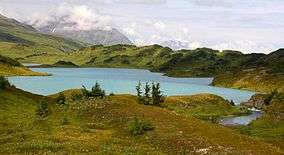Chugach National Forest
| Chugach National Forest | |
|---|---|
|
IUCN category VI (protected area with sustainable use of natural resources) | |
|
Lost Lake in Chugach National Forest | |
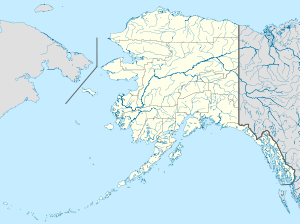 Location of Chugach National Forest in Alaska | |
| Location | Alaska, USA |
| Nearest city | Anchorage, AK |
| Coordinates | 60°27′41″N 149°07′34″W / 60.4614912°N 149.1259814°W[1]Coordinates: 60°27′41″N 149°07′34″W / 60.4614912°N 149.1259814°W[1] |
| Area | 6,908,540 acres (27,958 km2)[2] |
| Established | July 23, 1907 |
| Governing body | U.S. Forest Service |
| Website | Chugach National Forest |
The Chugach National Forest is a 6,908,540-acre (27,958 km2)[2] United States National Forest in south central Alaska. Covering portions of Prince William Sound, the Kenai Peninsula and the Copper River Delta, it was formed in 1907 from part of a larger forest reserve. The Chugach includes extensive shorelines, glaciers, forests and rivers, much of which is untouched by roads or trails. It hosts numerous bird, mammal and marine species, including extensive shorebird habitat and a bald eagle population larger than the continental 48 states combined. Human industry in the forest includes extensive tourism and some mining and oil and gas operations.
History
The area that is now Chugach was settled by Native Americans thousands of years ago. It was discovered by Europeans in the mid-1700s, and soon settled by Russian fur traders, who trapped the native sea otters. In 1867, the US purchased Alaska from Russia and gold was found in 1888. In 1907, the Chugach National Forest was created from a portion of forest reserve, which had been one of the first of its kind, designated in 1892.[3]
Geography
It is located in the mountains surrounding Prince William Sound including the eastern Kenai Peninsula and the delta of the Copper River.[4] It is the second-largest (third-largest if the Humboldt-Toiyabe National Forest is considered as one entity) forest in the U.S. national forest system,[2] and is the northern-most and western-most national forest. Approximately 30 percent of the area of the forest is covered by ice. Portions of the Kenai Peninsula make up approximately 21 percent of the forest, and include the southern portion of the Iditarod National Historic Trail. Parts of Prince William Sound make up about 48 percent of the forest. This includes 3,500 miles (5,600 km) of shoreline, 22 tidewater glaciers, and the Nellie Juan-College Fiord Wilderness Study Area, which covers 2,200,000 acres (8,900 km2). Portions of the Copper River Delta cover approximately 31 percent of the forest, and include the "largest contiguous wetlands complex on North America's Pacific coast". Despite its huge size, there are only 90 miles (140 km) of Forest Service roads, although there are also over 500 miles (800 km) of designated trails.[4]
The supervisor's office is located in Anchorage. There are local ranger district offices located in Cordova, Girdwood, and Seward.[5]
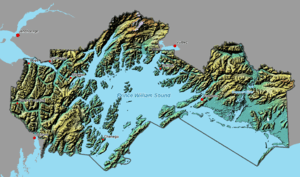
In descending order of land area within the forest it is located in parts of the Valdez-Cordova Census Area, Kenai Peninsula Borough, Anchorage Municipality, Matanuska-Susitna Borough, Kodiak Island Borough, and Yakutat City and Borough.[2]
Ecology
The Chugach is a temperate rain forest in the pacific temperate rain forest region. Here the forest occupies only a very narrow strip between the ocean and the icy alpine zone. The dominant trees are limited to sitka spruce, western hemlock and mountain hemlock. This zone is known as the"sub-polar rainforest".[6]
The Kenai Peninsula section of the forest is home to over 200 colonies of seabirds, as well as between 3,000 and 5,000 bald eagles. Approximately the same number of eagles live in the Chugach National Forest as live in the entire contiguous United States. The Copper River Delta portion of the forest is the largest contiguous portion of the Western Hemisphere Shorebird Reserve Network and is "considered one of the most essential shorebird habitats in the world".[4] The Delta provides habitat for over 20 million birds annually, and during the summer, one quarter of the world's trumpeter swans and dusky Canada geese call the Delta home. Other mammals in the forest include moose, caribou, Sitka black-tailed deer, mountain goats, black bears and grizzly bears. Dall sheep are also found; the Chugach is the only national forest where these animals can be seen. Humpback whales, sea lions and otters are found in the Chugach's waters.[3] The forest also hosts the king salmon, red salmon, silver salmon, chum salmon and pink salmon, which make up the five species of Pacific salmon found in North America.[4]
Human impacts
There is very little logging done in the Chugach, and less than 2 percent of the forest is considered suitable for commercial logging operations; this is unusual among national forests. Instead, the forest infuses money into local communities through tourism, recreation, mining and commercial fishing. There are over 7 million annual visitors to the Chugach National Forest, including kayakers, boaters, hikers, skiers, birders and anglers. None of the area is designated as national wilderness, although much of it qualifies under federal law. Mining, including coal and hard rock operations, and oil and gas development are found in the forest.[7] In 2003, the Department of the Interior (DOI) announced that 3,000 acres (12 km2) of forest was no longer open to mining, adding that area to almost 2,000 acres (8.1 km2) that had been previously placed offlimits. The affected land borders the Kenai National Wildlife Refuge Wilderness, and the DOI cited protecting the Russian River and upper Russian Lake Recreation Corridor as the reason for the change.[8]
Gallery
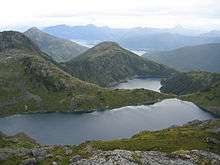 Alpine Lakes in the Chugach forest
Alpine Lakes in the Chugach forest Skiers cross Portage Lake
Skiers cross Portage Lake Spencer Glacier, in the Chugach Forest
Spencer Glacier, in the Chugach Forest Alpine trees in the Chugach forest
Alpine trees in the Chugach forest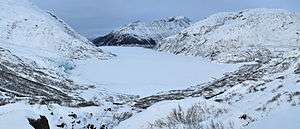 Portage Lake in winter
Portage Lake in winter- Byron Peak
See also
| Wikimedia Commons has media related to Chugach National Forest. |
References
- 1 2 "Chugach National Forest". Geographic Names Information System. United States Geological Survey.
- 1 2 3 4 "Land Areas of the National Forest System (As of September 30, 2011)" (PDF). 2012. Retrieved 2012-12-04.
- 1 2 "Chugach National Forest". US Forest Service. Retrieved 2013-12-03.
- 1 2 3 4 "Forest Facts". US Forest Service. Retrieved 2013-12-03.
- ↑ "Districts". US Forest Service. Retrieved 2013-12-03.
- ↑ "Temperate Rainforests of the North Pacific Coast". Ground Truth Trekking. Retrieved 2012-12-04.
- ↑ Fuselier, Katherine. "Chugach National Forest". Sierra Club. Retrieved 2013-12-03.
- ↑ Spence, Hal (March 7, 2003). "Mining nixed in 3,000 of Chugach". Peninsula Clarion. Retrieved 2013-12-03.
External links
- U.S. Forest Service site: Chugach National Forest
- Fire History Disturbance Study
- A History of the U.S. Forest Service in Alaska
- The Rainforests of Home, an Atlas of People and Place
- Temperate Rainforests of the North Pacific Coast
